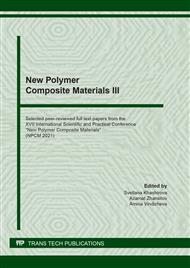[1]
O.A. Moskalyuk, E.S. Tsobkallo, A.S. Stepashkina and V.E. Yudin, Composites Based on Thermoplastic Polymeric Matrix and Carbon Nanoparticles with Special Functional Properties, Key Engineering Materials. 816 (2019) 244 – 249.
DOI: 10.4028/www.scientific.net/kem.816.244
Google Scholar
[2]
A.S. Balanev and E.S. Tsobkallo, Textile film threads with antistatic properties based on polypropylene with carbon fillers, TEXTILE-200. (2009) 204.
Google Scholar
[3]
E.S. Tsobkallo, D.V. Volnova and G.P. Meshcheryakova, The relationship between mathematical and structural modeling of the electrical conductive properties of composite film filaments with isotropic and anisotropic carbon filaments, Chemical fibers. 3 (2020) 8-14.
DOI: 10.1007/s10692-020-10169-8
Google Scholar
[4]
E.S. Tsobkallo, O.A. Moskalyuk, A.S. Stepashkina and V.E. Yudin, Transenergoplastics based on film composite materials, Materials of the 4th International Scientific Conference "Modern trends in the development of chemistry and technology of polymer materials. S-Pb. (2018).
DOI: 10.1007/s10692-019-09975-6
Google Scholar
[5]
O.A. Moskalyuk, E.S. Tsobkallo et al. Mechanical and electrical conductive properties of polypropylene fibers filled with carbon nanotubes with a functionalized surface, Journal of Applied Chemistry, 85 (2012) 957–962.
DOI: 10.1134/s1070427212050213
Google Scholar
[6]
D.V. Volnova, E.S. Tsobkallo and G.P. Meshcheryakova, Mathematical modeling of the concentration dependences of the electrical conductivity of film filaments filled with carbon nanotubes, Izvestiya VUZov. Light industry technologies. 43 (2019). 15-18.
Google Scholar
[7]
D.V. Volnova, E.S. Tsobkallo and G.P. Meshcheryakova Mathematical description of the electrical conductive properties of composite materials filled with carbon nanoparticles Design. Materials. Technology 3(55) (2019) 52-56.
Google Scholar


